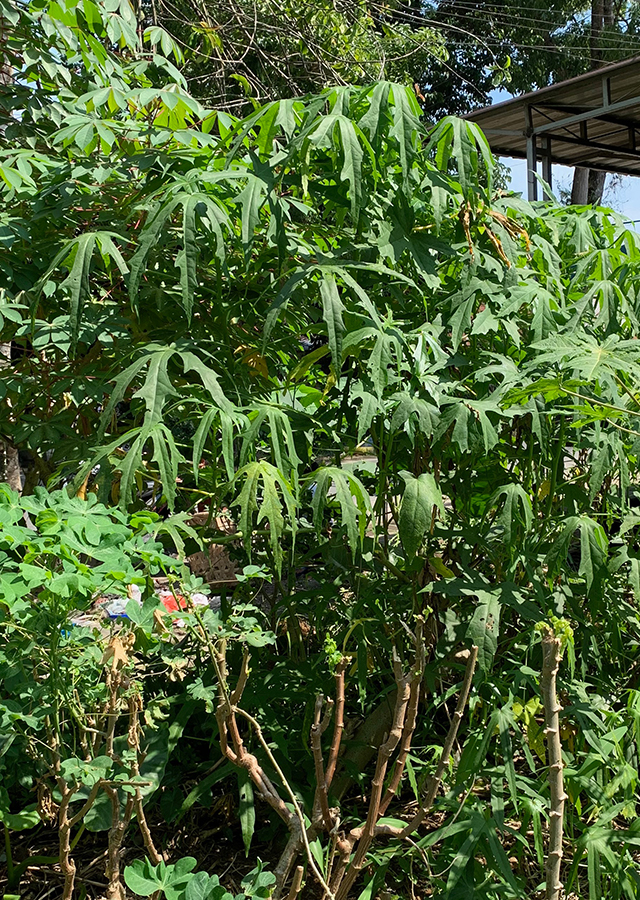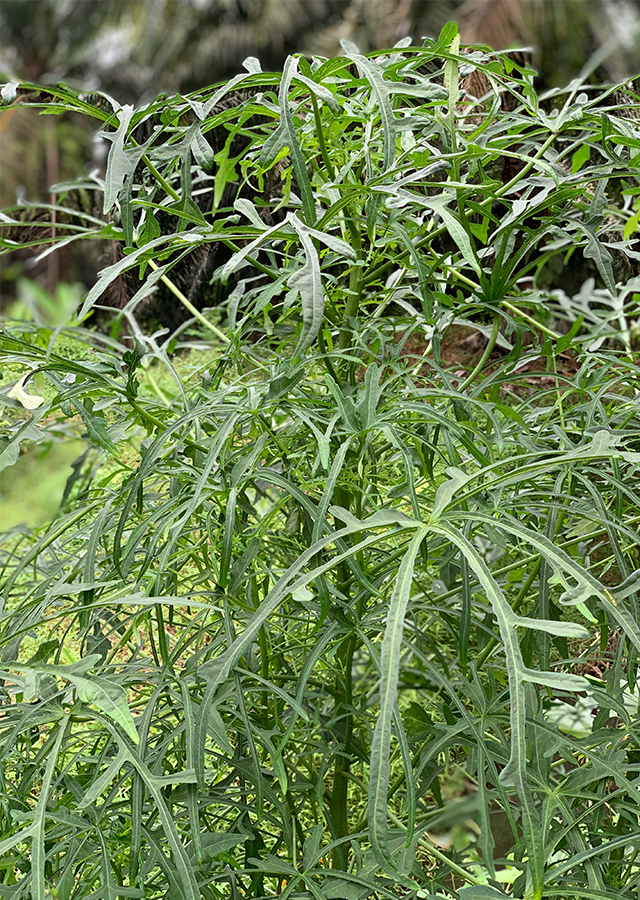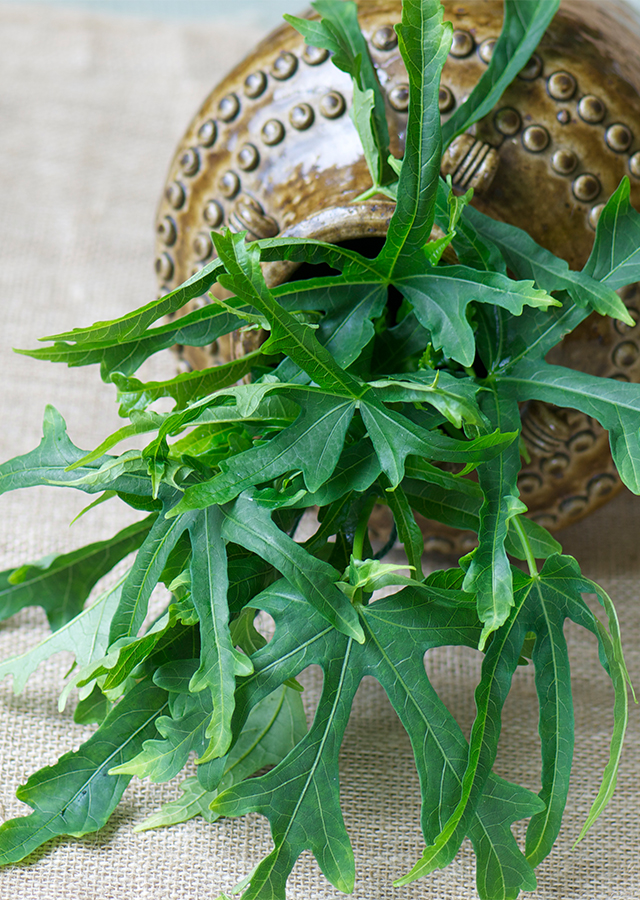Sunset Muskmallow
Abelmoschus manihot (L.) Medik.
Malvaceae
Location in our garden
Principal



Synonym
Abelmoschus maculatus Bartl.
Abelmoschus pentaphyllus (Roxb.) Voigt
Abelmoschus platidactylus (Bakh.) Nakai
Habitus
Shrubs. A quick-growing deciduous upright, perennial, 1-3 m tall, hermaphrodite, pollinated by insects, and can not grow in shade.
Part Used
Leaves
Bark
Flowers
Roots
Growing Requirements
Full Sunshine
High Rainfall
Habitat
Riverbanks
Rocky Areas
Shrublands
Grassland
Terrestrial
Overview
The origin of Sunset Muskmallow is in continental South-East Asia. Its species are primarily found in South Asia, Northern Australia, East Asia, and South-East Asia. A. Manihot is a cult with a wide variety. In Melanesia, it is a common traditional vegetable, but it has also been introduced as a vegetable or as an ornamental on other continents (sunset "hibiscus").
Vernacular Names
Aibika (Indonesia), Sweet Hibiscus (English), Maniok- Eibisch (Germany), Ketmie a feuilles de manioc (French), tenambere (Kiribati), Lagikuway (Philippines), Po-fai (Thailand), Dakpul (Korea),Tororoaoi (Japan).
Agroecology
Abelmoschus manihot grows over a broad variety of climates but occurs mostly from the lowlands to 1,200 m altitude in the tropics. However, production is slower at high elevations. For good production, it needs well-distributed precipitation of at least 1,200 mm/year. It is vulnerable to waterlogging and with a pH of 5.5-7. Prefers well-drained loams in a sunny position, but grows on a wide variety of soils.
Morphology
- Roots - usually adventitious and fairly shallow with most of the roots in the top 30-40 cm of the soil.
- Stems - erect, woody, branching, glabrous or pubescent.
- Leaves - simple, alternate, extremely variable in shape, size, color, and pigmentation.
- Flowers - large, bell-shaped, 7-15 cm in diameter, axillary, solitary, or in racemes by the reduction or abortion of the upper leaves.
- Fruits - oblong-ovoid capsule, 4-6 cm long with 2-3 cm in diameter.
- Seeds - numerous, spherical to reniform, 2-4 mm in diameter, black.
Cultivation
- During the first 2-3 months, Abelmoschus manihot that is propagated from cuttings grows very slowly and does not adequately cover the ground. The frequent removal of the rising tips promotes branching and compact bushy growth after harvesting has begun, and delays flowering.
Chemical Constituents
Flavanoids, amino acids, nucleosides, polysaccharides, organic acids, steroids, volatile oils, `myricetin, cannabiscitrin, myricetin-3-O-beta-D-glucopyranoside, glycerolmonopalmitate, 4-dihydroxy benzoic acid, guanosine, adenosine, maleic acid, heptatriacontanoic acid, 1-triacontanol, tetracosane, beta-sitosterol-3-O-beta-D-glucoside.
Traditional Medicinal Uses
- It is said that the bark was an emmenagogue.
- This herb's seeds control the proper functioning of the stomach and provide strength.
- The digestive system strengthens and prevents indigestion.
- Asthma is also handled by reliefs from bronchitis, causing cough and breathlessness ad.
- Provides relief, since it is demulcent, from inflammation of the mucous membranes.
- Traditionally, it has been used to treat inflammation, discomfort, urinary infections, and chronic bronchitis.
- Bark paste is used to treat wounds and cuts, with fresh paste being applied for around 3 weeks every 2-3 days.
- The root juice is warmed up and applied to sprains in Nepal.
- Flower juice is used for the prevention of chronic bronchitis and toothaches.
- Bark juice helps to minimize swelling and sores in the muscles.
Part Used
Reference Sources
- Gurnah, A.M. (2016). Pl@nt Use. Abelmoschus manihot (PROSEA). https://uses.plantnet-project.org/en/Abelmoschus_manihot_(PROSEA). 17-08-2020
- Herbpathy. (No date). Abelmochus manihot. https://herbpathy.com/Uses-and-Benefits-of-Abelmoschus-Manihot-Cid7029. 14-12-2020.
- Luan,F., Wu, Q., Yang, Y., Lv, H., Liu, D., Gan, Z. & Zeng, N. (2020). Traditional uses, chemical constituents, biological properties, clinical settings, and toxicities of Abelmoschus manihot L.: a comprehensive review. Front. Pharmacol. http://doi.org/10.3389/fphar.2020.01068
- Medicinal Herbs. (No date). Aibika Abelmoschus manihot. http://www.naturalmedicinalherbs.net/herbs/a/abelmoschus-manihot=aibika.php.17-08-2020
- PubMed. (No date). Abelmochus manihot. https://pubmed.ncbi.nlm.nih.gov/17165583/. 14-12-2020
- Research Gate. (2011). ArticlePDF Available Abelmoschus manihot Linn: ethnobotany, phytochemistry and pharmacology. https://www.researchgate.net/publication/266569418_Abelmoschus_manihot_Linn_ethnobotany_phytochemistry_and_pharmacology. 17-08-2020
- San Marcos Growers (No date). Abelmoschus manihot-Aibika.https://www.smgrowers.com/products/plants/plantdisplay.asp?plant_id=4282. 14-12-2020.


